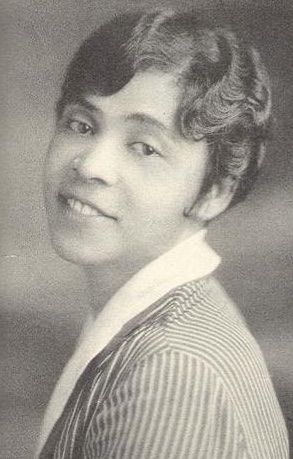Thyra J. Edwards facts for kids
Thyra Johnson Edwards (December 25, 1897 – July 9, 1953) was an amazing African-American woman. She was a teacher, social worker, and journalist. She also worked hard as an activist for workers' rights, civil rights, and women's rights. She believed in helping people from all over the world and worked for a better society for everyone.
Contents
Early Life and Education
Thyra Johnson Edwards was born in 1897 in Wharton, Texas. Her parents were Horace Ferdinand Edwards and Anna Bell Johnson Edwards. Her grandparents had escaped slavery and moved from Missouri to Illinois. Thyra's mother was a teacher. Both of her parents were very involved in helping their community. Later, her family moved to Houston.
Thyra graduated from Houston Colored High School in 1915. She had friends of different races and noticed how skin color affected people's lives. She studied to become a social worker at the Chicago School of Civics and Philanthropy. She also learned about workers' rights at Brookwood Labor College. In 1933, she continued her studies in Denmark at the International People's College.
Exploring New Ideas
In the early 1930s, Thyra Edwards traveled to the Soviet Union. She wanted to see if their ideas could create a better society.
Making a Difference: Her Career
After high school, Thyra started as a teacher in Texas. In 1918, she became a founding member of the Houston chapter of the NAACP. This group works for the rights of African Americans. In 1919, she began working as a family visitor for the Houston Social Service Bureau. This was the start of her social work career.
The next year, she moved to Gary, Indiana, with her sister, Thelma. For the next twelve years, she worked as a teacher, social worker, and juvenile probation officer. She also lectured and became more involved in helping workers and fighting for civil rights.
In 1925, she became a child placement specialist. This meant she helped find good homes for children. In 1927, she helped open the Lake County Children's Home and was its director for three years. She also helped start Gary's Interracial Commission in 1924. This group worked to improve relations between different races. She was also on the board of the John Stewart Social Settlement Center, which helped African Americans in Gary.
Thyra organized the Business and Professional Women's Club in Gary. She spoke at a national conference in 1927. She was also a leader in the Gary Council of Social Agencies and active in the city's YWCA.
Chicago and Beyond
In 1929, Edwards traveled in Europe. In 1931, she moved to Chicago to work as a social worker. She soon became active with the Brotherhood of Sleeping Car Porters, a union for Black workers. She also worked with the Progressive Miners of America. In 1933, she helped form the Chicago Scottsboro Action Committee.
Thyra Edwards believed in a worldwide approach to social work. She wrote in journals, worked in communities, and helped organize unions. Her social work focused on helping people who were at risk or faced disadvantages. She also worked to unite people from different backgrounds.
At that time, many people thought Black social workers should only help Black people. But Thyra Edwards helped people of all races and backgrounds.
International Work and Writing
In the early 1930s, Thyra Edwards traveled to Europe to work on international issues. She visited Sweden, Finland, Poland, Germany, and France. In Paris, she led a travel seminar called The European Seminar of International Relations. This group of social workers explored social movements in Europe.
The seminar traveled to Spain and the Soviet Union. At that time, the Soviet Union was seen as a safe place for Black activists. Edwards also attended a big meeting against racism and discrimination.
Helping Children in War
While in Europe, she spent a lot of time helping during the Spanish Civil War. She worked with other experts to check on children who had to leave their homes because of the war. When she returned to America, she continued to help Spain through the Negro Committee to Aid Spanish Democracy. The famous writer Langston Hughes admired her work.
In 1953, while traveling in Europe, she helped start the first Jewish child care program in Rome. This program helped children who had suffered during the Holocaust.
Thyra Edwards supported the Loyalists in the Spanish Civil War. She traveled to Europe, the Soviet Union, and Mexico for her work. Because of her international activities, the FBI watched her work until she passed away.
As a Journalist
As a journalist, Edwards wrote articles for the Associated Negro Press. She wrote about her travels for African-American newspapers and magazines. In 1932, she wrote about a shelter for homeless men in Chicago. In 1933, she interviewed Nigerian lawyer Stella Thomas. She described her as "tall and black and real and beautiful and poised, and wrapped in flame." She also wrote "Negro Literature Comes to Demark" in 1936.
She wrote a series of articles about the Spanish Civil War for the Chicago Defender. In these articles, she showed her support for socialism and her strong opposition to fascism. She believed that "Fascism degrades women."
Personal Life
Thyra J. Edwards married steelworker James Malcolm Garnett in 1924, but they divorced a year later. She married again in 1943 to Murray Gitlin. After 1948, they lived in Italy, where he worked with a Jewish aid organization.
In 1946, Thyra was diagnosed with rheumatoid arthritis. Later, she was diagnosed with breast cancer. Thyra Edwards Gitlin passed away in New York in 1953, at 55 years old, from breast cancer. Her important papers are kept at the Chicago History Museum. The actor William Marshall was Thyra Edwards' nephew. He was the son of her sister, Thelma Edwards Marshall.


